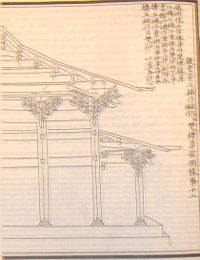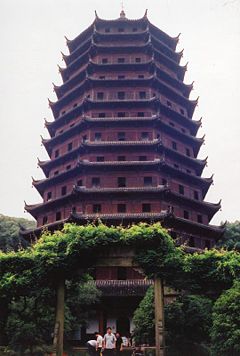|
Pre
The architecture of the Song Dynasty (9601279) was based upon the accomplishments of its predecessors, much like every subsequent dynastic period of China. The hallmarks of Chinese architecture during the Song period were its towering Buddhist pagodas, enormous stone and wooden bridges, its lavish tombs, and palatial architecture. Although literary works on architecture existed beforehand, during the Song Dynasty literature on architecture blossomed into maturity and held a greater professional outlook, described dimensions and working materials in a concise manner, and overall had a greater style of organization than previous works. Architecture in Song artwork and illustrations in published books showing building diagrams also aid modern historians in understanding all the nuances of architecture originating from the Song period. The profession of the architect, craftsman, carpenter, and structural engineer were not seen as high professions equal to the likes a Confucian scholar-official in pre-modern China. Architectural knowledge was passed down orally for thousands of years in China, from a father craftsman to his son (if the son wished to continue the legacy of his father). However, there were government agencies of construction and building along with engineering schools. The Song literature of building manuals aided not only the various private workshops, but also the government employees enlisted as craftsmen for the central government. During the Han Dynasty (202 BC220 AD) of China, the idea of the Buddhist stupa entered Chinese culture, as a means to house and protect scriptural sutras. During the Southern and Northern Dynasties period, the distinct Chinese pagoda was developed, its predecessor being the tall watchtowers and towering residential apartments of the Han Dynasty (as seen through Han-era tomb models).[1][2] During the Sui (581618) and Tang (618907) periods, Chinese pagodas were reverted from purely wooden architecture into articulated stone and brick, which could more easily survive lightning fires, arson, and avoid the natural rotting of wooden material over the ages. The earliest existent brick pagoda is the Songyue Pagoda built in 523, while a good example of a Tang era stone pagoda would be the Giant Wild Goose Pagoda constructed by 652. Although Buddhism in China had waned in influence after the late Tang period, during the Song Dynasty there were numerous Buddhist pagoda towers built. Tall Chinese pagodas were often built in the surrounding countryside instead of within the city walls, due to its foreign origin in India, and the Chinese not wanting it to compete with the cosmic-imperial authority embodied in the cities' drum-towers and gate-towers. However, there were pagodas that were built within the city's walls; an example would be the Giant Wild Goose Pagoda, built in a city ward of what was southeastern Chang'an. Chinese Religious Building The 'Iron Pagoda' of Youguo Temple in Kaifeng is an excellent example of Song-era architecture, earning its name because of the iron-grey color of the glazed-bricks forming the tower. Originally built as a wooden pagoda by the architect Yu Hao, it was struck by lightning and burned down in 1044 during the Northern Song period. In 1049 the pagoda was rebuilt as it appears today, under the order of Emperor Renzong of Song. This octagonal-base pagoda structure stands at a current height of 56.88 meters (186.56 feet tall), and with a total of 13 story levels.It's glazed tile bricks feature carved artwork of dancing figures, solemn ministers, and Buddhist themes . The Iron Pagoda of Kaifeng, built in 1049 AD, 57 m (187 ft) tall.However, China also featured real iron-cast pagodas, such as the Iron Pagoda of Yuquan Temple (Jade Springs Temple), Dangyang, Hubei Province. Built in 1061 AD during the Northern Song, it holds a weight of 53848 kg (53 t) of cast iron, at a standing height of 21.28 m (70 ft tall).[5] In mock and model after the roofing tiles of actual wooden, stone, or brick pagodas of the Song period, this iron pagoda also features delicate sloping eaves, and has an octoganal-shaped base.[6] The Liuhe Pagoda, or Six Harmonies Pagoda, is another famous Song-era work of pagoda architecture. It is located in the Southern Song capital of Hangzhou, Zhejiang Province, China, at the foot of the Yuelun Hill facing the Qiantang River. Although the original was destroyed in 1121, the current tower was erected in 1156, fully restored by 1165. It stands at a height of 59.89 m (196 ft tall), constructed from a red-brick frame with 13 layers of wooden eaves. The Liuhe Pagoda, being of considerable size and stature, served as a permanent lighthouse from nearly its beginning, to aid sailors in seeking anchorage for their ships at night (as described in the Hangzhou Fu Zhi).[7] During the Southern Song period, it was one of the crowning pieces of architecture for the capital city. The Twin Pagodas of Kaiyuan Temple in Quanzhou are also renowned within China. The first pagoda, the Zhenguo Pagoda, was originally built of wood during the Xiantong period (860873). Its twin structure, the Renshou Pagoda (also originally constructed with wood) was built in 916 AD. After being destroyed several times by fire and other calamity, the present Renshou Pagoda was built of stone in 1228 AD, while its twin structure of the Zhenguo Pagoda was also built of stone in 1238 AD (sponsored by a Buddhist monk known as Bengong). The Renshou Pagoda is 44.6 m tall, while the Zhenguo Pagoda is slightly taller, at a height of 48.24 m tall. The wooden dougong-constructed Pagoda of Fogong Temple, located in Shanxi, 67 m (221 ft) in height, built in 1056 AD.The Zhengjue Temple Pagoda in Pengxian County of Sichuan Province (near Chengdu) is a brick pagoda that was built between 1023 and 1026 AD, according to its inscriptions along the first story of the pagoda. The pagoda has a square base on a sumeru pedestal, stands at thirteen stories in a total of 28 m in height, and its multiple layers of eaves are similar in style to the earlier Tang Dynasty pagodas found in Chang'an, the Giant Wild Goose Pagoda and Small Wild Goose Pagoda. Inside the pagoda the staircase reaches up to the fourth story under a vault ceiling. The Liao Dynasty to the north was also famous for its Buddhist pagoda architecture. Although many brick and stone pagodas, and brick-stone/wood hybrid pagodas built beforehand have survived the ages, the tallest and oldest fully-wooden pagoda still standing in China was of Liao-Khitan making, the Pagoda of Fogong Temple (also called Sakyamuni Pagoda).[8][9] Located in Ying County of Shanxi Province, the octogonal-base pagoda was built in 1056 AD, as a crowning architectural masterpiece of the Fugong Temple. The pagoda stands at a height of 67.13 m (220.18 ft) tall, making it taller than both the Iron Pagoda and the Liuhe Pagoda of the Song Dynasty.[10] The pagoda also features just under sixty different kinds of bracket arms in its construction.[11] The pagoda was built in a similar style to the Liuhe Pagoda, with its delicate wooden eaves and curving tiles, and along with the other pagodas it is a site of tourist attraction in modern times. Apparently, the pagoda was built by Emperor Daozong of Liao (Hongji) at the site of his grandmother's family home.[12] The pagoda reached such fame that it was simply nicknamed the "Mu-ta" (Timber Pagoda) in China.[9] While the Yingxian Pagoda is the oldest existent fully-wooden pagoda in China, the oldest-existent fully-wooden building in China is the main temple hall at Nanchan Monastery of Mount Wutai, Shanxi, built in 782 during the Tang Dynasty (it is a common misconception that the larger East Hall of nearby Foguang Temple, built in 857, is the oldest existent Tang era wooden building). Pizhi Pagoda of Lingyan Temple, Shandong, 54 m (177 feet) in height, built in 1063 AD.Wood-and-brick hybrid pagodas were also built, such as the 42 m (137 ft) tall Lingxiao Pagoda of 1045. The first four floors of this octagonal pagoda are brick (with wooden eaves), while the 5th floor up is entirely made of wood. Even fully brick and stone pagodas featured architectural elements that were typical of wooden Chinese buildings, such as the Pizhi Pagoda built from 1056 to 1063, which features the typical dougong brackets of wooden architecture that hold up pent, shingled roofs and tiers. Both of these pagodas feature interior staircases, although the staircase for the Lingxiao Pagoda only reaches the fourth floor, and the Pizhi Pagoda's interior staircase only reaches the fifth floor. However, the Pizhi Pagoda features winding exterior steps which allow one to visit the top ninth floor where the iron steeple is located. Although the Pagoda of Fogong Temple is the tallest existent wooden pagoda, the tallest existent Chinese pagoda of the pre-modern age is the Liaodi Pagoda. Completed in the year 1055, it stands at a height of 84 m (275 ft) tall, with an octagonal base on a large platform. It surpasses the height of the 69 m (227 ft) tall Qianxun Pagoda, which was earlier the tallest pagoda in China when built in the 9th century by the Kingdom of Dali. Although Liaodi served its religious purpose as a Buddhist landmark in the Kaiyuan Monastery of Ding County, Hebei province, with its great height it served another valuable purpose as a military watchtower used to spot enemy movements of the Khitan Liao Dynasty.[14] Besides watchtowers, towers could also serve as large astronomical observatories. This includes the Gaocheng Astronomical Observatory built in 1276 AD, still standing today. 
|
|
|
|



